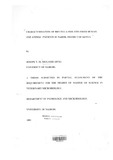| dc.description.abstract | Brucellosis is a cosmopolitan zoonotic disease that afflicts man, his domestic
animals and wildlife. The smooth members of the genus are the main culprits
worldwide. The incidence of the disease in humans, and which directly relates to
that in animals, is highly dependent on animal husbandry practices, animal
population, animal population density and inter-group interactions. Disease in
humans is related to the interaction between humans and animals, living standards,
hygiene and food customs. Owing to these reasons, Narok, the district where this
study was undertaken, has the full potential for high occurrence of brucellosis both
in animals and humans. It is for this reason that this study was undertaken with the
aim of recovering Brucella pathogens from man and animals; to gain an insight
into the prevalence in animals through sero-survey and where possible to establish
the sources of infections to the human patients.
The study was carried out in thre,e overlapping phases in which human patients
clinically suspected of brucellosis, in the opinion of the clinician, had two 10ml
blood samples collected from the radial vein into vacutainer tubes. One sample
was collected and preserved in a vacutainer tube containing potassium oxalate
while the other sample, for serum harvesting, was collected into a tube without the
anticoagulant. Hemoculture of the preserved blood was done into diphasic
medium for not less than eight weeks. The human samples for culture were
chosen on the basis of a quick Rose Bengal plate test (RBPT) on serum, carried
out at the point of sampling. This led to the culture of 397 patients who tested
positive and 134 (one in five) of the negative ones, all totalling 531. The total
human serum samples were 957.
The selection of animal herds was random, using multistage computer methods,
and also specific i.e. home herds in which human patients' blood had shown signs
of growth or the serum was positive on RBPT. From each home herd, a random
sample of 20 cattle, 10 sheep and 10 goats were chosen and each animal had lOml
of jugular blood collected into a vacutainer tube. Animals with signs implicative
of brucellosis such as lameness, abortion or hygroma had a second 10ml of blood
taken for hemoculture as in the human suspects. In all, cattle sera were 1,620,
caprine 1,257 and ovine 557. The cultured animal blood were 388 comprising 132
cattle, 196 goats and 50 sheep; out of which 54 cattle, 73 goats and 34 sheep had a
history of abortion.
The human and animal sera were simultaneously screened at the central Veterinary
Investigation Laboratories (Vet Labs), Kabete; using Rose Bengal plate test
(RBPT) , Serum agglutination test (SAT) and Complement fixation test (CFT).
Thus, the human serum was tested on RBPT twice; at the sampling points and at
Vet Labs Kabete.
From the 531 cultured human blood samples, Brucella abortus, Yersinia and
Campylobacter species were isolated three, eight and 11 times, respectively. From
the cultured animal blood, only Campylobacter species were realised in one cow,
eight goats and 11 sheep. The 957 human sera yielded a cumulative total of 78
(8.2%) reactors with individual test results being; RBPT 62 (6.5%), SAT 40
(4.2%) and CFT 23 (2.9%). From the 1620 cattle sera tested, 177 (10.9%)
cumulative reactors were realised with RBPT picking 75 (4.6%), SAT 136 (8.4%),
and CFT 53(3.3%). The 1257 caprine sera had 106 (8.4%) reactors with RBPT
picking 38(2.7%), SAT 69(5.5%) and CFT 39(3.1 %), while the ovine reactors
were 45(8.1 %) with RBPT picking 23(4.1 %), SAT 19(3.4%) and CFT 16(2.9%),
respectively.
From the serological results, it is clear that brucellosis is widely distributed in
Narok District both in human beings and in animals. Many human cases were
misdiagnosed both clinically and serologically probably due to poor interpretation
of RBPT results and also due to cross-reactivity as a result of infections by other
I
organisms such as Yersinia species. Clinical misdiagnosis could be due to
inadequate understanding of the possible differentials, while poor interpretation of
RBPT readings could be a result of inadequate training. This poor interpretation
of RBPT results led to prolonged antibiotic treatment on patients, who otherwise
were without brucellosis. Isolation of Yersinia species was accompanied by
positive RBPT results, while that of Campylobacter species showed no crossxv
reaction. Yersiniosis, campylobacteriosis and probably typhoid, may be a big
menace especially in place and times when human resistance is compromised by
malnutrition as in this case. These other diseases are directly linked to lack of
clean drinking water, poor personal hygiene and absence of toilets.
The serological results tend to imply that sheep and goats aborted due to
brucellosis as flocks with a high rate of abortion also had higher reactor rates.
Also, the serological reactors in the flocks with a high rate of abortion tended to
have higher titres than the titres realised in the reactors from flocks with low
abortion rate or those that had no abortions at all. Also, the three serological tests
used, tended to agree more in groups with high abortion rates than in the groups in
which no abortions had been noticed.
Campylobacteriosis is another common cause of abortion particularly in small
ruminants in which it was isolated only from sero-negative sheep and goats with
abortion. | en |

